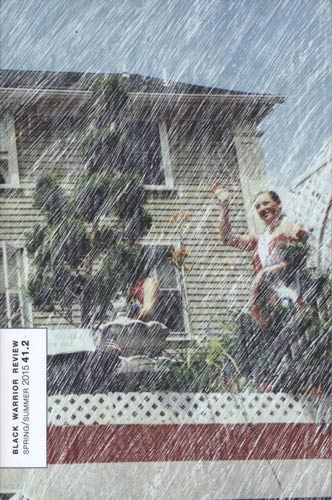Black Warrior Review – Spring/Summer 2015
Before I began reading this issue of Black Warrior Review I skimmed its pages to see what they had in store for me. As it turned out, the pages held more than I could have ever expected, such as a chapbook by Nicole Walker, the graphic prose of Jeffery Chapman, a small section of featured work which includes everything from fiction and nonfiction to a graphic short story and artwork by Melissa Zexler. Needless to say that before I even started this issue, my mind was buzzing with excitement to read every single page. Before I began reading this issue of Black Warrior Review I skimmed its pages to see what they had in store for me. As it turned out, the pages held more than I could have ever expected, such as a chapbook by Nicole Walker, the graphic prose of Jeffery Chapman, a small section of featured work which includes everything from fiction and nonfiction to a graphic short story and artwork by Melissa Zexler. Needless to say that before I even started this issue, my mind was buzzing with excitement to read every single page.
The issue starts off with a nonfiction piece by Caroline Crew titled “No Aperture.” In this piece, Crew addresses the issue of rape, issues that rape can cause, and how society attempts to dictate how women handle the issue of rape. The piece is composed of short vignettes that weave several narratives together, everything from Crew’s own history to the history of nail polish. Crew writes:
[ . . . ] Chanel’s ‘Vamp’. This deep red-black is evocative of Nefertiti [ . . . ] staining her nails with henna & blood. Though a red lip links its cosmetic application to sex, supposedly conjuring the flushed gloss of the labia when aroused, the longevity of red nails appears less obvious. Originating in China, nail polish develops as a marker of social class: red becoming the pinnacle. As if having blood on your hands is a status symbol.
The reader is not only told what Crew experiences, but they are also given the history behind the experiences. I left this piece feeling like I had truly learned multiple things and connected to the writer’s personal story.
As I read more and more of this issue, I began to notice that lists were a prominent theme among all works, especially poetry and fiction. In Sally Wen Mao’s piece “Yume-Miru Kikai [The Dream Machine]” the speaker creates a list elegizing not only Satoshi Kon, the creator of the unfinished anime “The Dream Machine,” but of “The Dream Machine” itself as well as a relationship with a lover. Mao flawlessly incorporates pulled text from Kon’s last letter, Kon’s life story, and Kon’s work to create a poem that can speak to both readers who are familiar with Kon’s work and those who are not. The reader can see both Kon and the relationship being elegized in the dialogue that is created between #17 and #21. #17 is fully pulled text from Kon’s last letter and reads, “And if I may ask you one more thing—could you help my wife send me over to the other side after death? I’d be able to get on that flight with my mind at rest if you could do that for me. I ask this from my heart.” And then in #21 the speaker states, “On someone’s bed, I read Satoshi’s last letter [ . . . ] A beautiful man lay beside me, unmoved. His perfect ribs did not shake. This is how I knew to go.”
Lists continued in Simon Jacob’s fiction piece “The Ways I’ll Kill Him/The Ways I’ll Die.” This story is organized into five sections: 1. Clammy Hands, 2. Lead Feet, 3. Bounce, 4. Itchy Fingers, and 5. Hara-Kiri. In each section the narrator likens being broken up with to a different way of being killed by their ex. The story is short but lacks no emotion that surrounds a break up such as heartache, anger or helplessness. The opening line of section five, Hara-Kiri, reflects the twisted nature of the relationship of the narrator and their partner. Section five begins, “I know that you’ve secretly always wanted to watch me bleed out.”
There is no shortage of fresh ideas in any of the work in this issue of Black Warrior Review. In Zach Powers’s fiction piece “Children in Alaska,” the reader follows the story of a man and his wife, who just happens to be a lightbulb. The story follows the couple through several years of their life and explores the sense of otherness they experience as well as the limitations they encounter and attempt to overcome because the husband is a human and the wife is a lightbulb.
Whether you are in the market for something visually stimulating or you are looking for some great writing to get your hands on, this issue of Black Warrior Review has you covered. Remember, with this issue not only are you getting the normal issue of BWR, but you are also getting a full-length chapbook as well! I read so many lines that made me want to go write, that I know you will as well. For all of you who don’t consider yourselves writers, this issue will provide you with work that will stick with you and ask you to continuously revisit it, only to discover a new layer to each and every piece each time you read.
[www.bwr.ua.edu]





